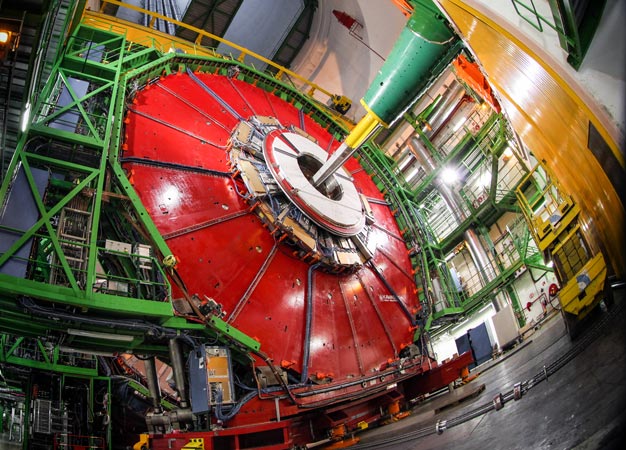The see-sawing behavior of dark-matter particles might have jolted experiments at the LHC
Published online 23 February 2017

In 2015, the CMS detector at the Large Hadron Collider spotted evidence of a mysteriously heavy particle that may be related to dark matter.
© 2017 CERN, for the benefit of the CMS Collaboration
Unexpected signals in experiments at the Large Hadron Collider (LHC) could have been caused by heavy and light versions of a potential dark-matter particle known as the axion, propose researchers at Keio University1.
Studies indicate that the Universe contains about six times more mass than can be seen with normal telescopes. Researchers once believed that this transparent or 'dark' matter was made mostly from abundant subatomic particles known as neutrinos, but recent cosmic observations disproved their hypothesis. Instead, researchers are now focusing on finding the axion, a theoretical particle predicted forty years ago as a way to solve problems in the standard model of particle physics.
Similar to a photon, but with definite mass, axions should exist in sufficient quantities to account for dark matter in the Universe. Physicists are methodically searching for these particles by scanning the microwave spectrum for weak resonance signals, and looking for the creation of a new photon ― a key indicator that an axion was captured. But spotting extremely miniscule axion resonances amid a constant background of cosmic microwave radiation left over from the Big Bang requires extraordinary luck.
To better their odds, researchers are smashing light beams together in the most powerful accelerator ever built in the hope that scattering particles can illuminate previously inaccessible parts of the microwave spectrum. In late 2015, an LHC team uncovered evidence of something resembling an axion, but different in key ways ― the resonance signal had an excess of energy ― decaying into, not one, but two photons ― and had a mass much heavier than predicted theoretically.
"When we saw this signal, we honestly had no idea whether it was genuine because there weren't any good reasons for a new state to exist," says Tetsutaro Higaki from the Department of Physics at Keio University. "But if it was real, we thought it had to be related to dark matter."
Higaki and his colleagues from Japan and South Korea theorized that the excess resonance belonged to a different type of axion. Through a model known as a see-saw mechanism, they predicted that heavy axions could align and generate the lightweight axions expected from particle physics through a mixing of quantum states. This theory concurs with models of the Universe's expansion, and explains why axions have been so tricky to find ― scientists may have been looking in the wrong energy region.
"The heavy axions might be observed as new excesses when the LHC can get to higher energy scales," notes Higaki.
Reference
-
Higaki, T., Jeong, K. S., Kitajima, N. & Takahashi, F. The QCD axion from aligned axions and diphoton excess. Physics Letters B 755, 13-16 (2016). | article